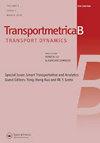考虑交通动态的路网资金约束维修调度
IF 3.4
2区 工程技术
Q2 TRANSPORTATION
引用次数: 0
摘要
本文章由计算机程序翻译,如有差异,请以英文原文为准。
Capital-constrained maintenance scheduling for road networks considering traffic dynamics
Road network maintenance scheduling mainly considers budget limits in the previous studies and largely ignores the capital constraints. This study proposes a bi-objective mixed integer programming model, in which the net present value (NPV) is maximized and the increased total system travel time (ITSTT) due to maintenance activities under the capital constraints is minimized. Since the road network flows cannot reach an equilibrium state overnight due to the variation of network capacity, a link-based day-to-day dynamics model is developed to simulate the transient fluctuation in the traffic flows and calculate the total system travel time of each day. The bi-objective model is solved by the nondominated sorting genetic algorithm-II (NSGA-II) that generates a set of optimal Pareto solutions. The TOPSIS method is then adopted to determine the best compromise solution. Finally, a case study is conducted to demonstrate the effects of key parameters on the values of the two objectives.
求助全文
通过发布文献求助,成功后即可免费获取论文全文。
去求助
来源期刊

Transportmetrica B-Transport Dynamics
TRANSPORTATION SCIENCE & TECHNOLOGY-
CiteScore
5.00
自引率
21.40%
发文量
53
期刊介绍:
Transportmetrica B is an international journal that aims to bring together contributions of advanced research in understanding and practical experience in handling the dynamic aspects of transport systems and behavior, and hence the sub-title is set as “Transport Dynamics”.
Transport dynamics can be considered from various scales and scopes ranging from dynamics in traffic flow, travel behavior (e.g. learning process), logistics, transport policy, to traffic control. Thus, the journal welcomes research papers that address transport dynamics from a broad perspective, ranging from theoretical studies to empirical analysis of transport systems or behavior based on actual data.
The scope of Transportmetrica B includes, but is not limited to, the following: dynamic traffic assignment, dynamic transit assignment, dynamic activity-based modeling, applications of system dynamics in transport planning, logistics planning and optimization, traffic flow analysis, dynamic programming in transport modeling and optimization, traffic control, land-use and transport dynamics, day-to-day learning process (model and behavioral studies), time-series analysis of transport data and demand, traffic emission modeling, time-dependent transport policy analysis, transportation network reliability and vulnerability, simulation of traffic system and travel behavior, longitudinal analysis of traveler behavior, etc.
 求助内容:
求助内容: 应助结果提醒方式:
应助结果提醒方式:


